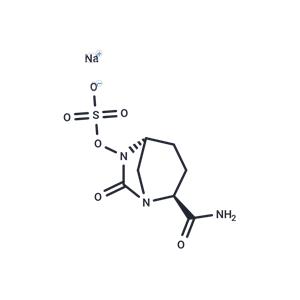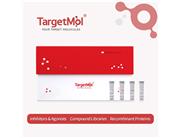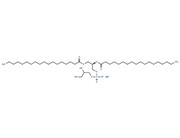| Name | Avibactam sodium |
| Description | Avibactam sodium (NXL-104) is a non-β-lactam β-lactamase inhibitor that inhibits TEM-1, P99, and KPC-2 β-lactamases (IC50=8/80/38 nM) covalently and reversibly. Avibactam sodium has antimicrobial activity and can be used to treat urinary tract infections. |
| Cell Research | Avibactam is prepared in sterile water[2].Cells (~109 cfu) from overnight broth culture are spread on Mueller-Hinton agar supplemented with either (i) Ceftaroline plus Avibactam (1 or 4 mg/L) at 1-16× the MICs or (ii) Ceftaroline at 1 or 4 mg/L plus Avibactam at 1-8× the concentration needed to reduce the Ceftaroline MIC to 1 or 4 mg/L. Colonies are counted after overnight incubation and representatives are retained[2]. |
| Kinase Assay | In a 200 μL reaction volume, 1 μM TEM-1 is incubated with and without 5 μM Avibactam for 5 min at 37°C and subjected to two ultrafiltration cartridge (UFC) steps to remove excess inhibitor (Ultrafree-0.5 with Biomax membrane, 5-kDa cutoff). Centrifugation at 10,600× g for 8 min is performed at 4°C. After each ultrafiltration step, 20 μL retentate is diluted with 180 μL assay buffer to restore the original enzyme concentration. After two UFC treatments, the amount of free Avibactam is quantified by LC/MS/MS and found to be <5% of the original concentration. Loss of protein during UFC is assessed by measuring TEM-1 activity (on 4,000-fold dilution) in the acyl-enzyme sample compare with a non-UFC-treated enzyme, and loss is found to be <5%[1]. |
| Animal Research | Avibactam is reconstituted in sterile water to a stock solution of 5,120 mg/L and the further solution is prepared in Mueller-Hinton broth. Outbred female CD-1 mice, 7 to 8 weeks old and weighing 20 to 25 g, are used in the experiments. Eight dose combinations are used. For the thigh-infected animals, the combinations of Ceftazidime and Avibactam are 16/4, 8/1, 64/32, and 2/128 mg/kg. For the Lung-infected mice, combinations of 32/16, 4/2, 128/8, and 1/64 mg/kg of the respective constituents are used. These combinations are chosen in order to detect possible pharmacokinetic interactions between the two compounds (Ceftazidime and Avibactam) and to cover a wide range of doses of each compound. |
| In vitro | METHODS: Breast cancer cell lines were treated with (E/Z)-4-Hydroxytamoxifen for 4 h and cell growth was detected.
RESULTS: (E/Z)-4-Hydroxytamoxifen was able to inhibit the growth of four breast cancer cell lines, MCF-7, MCF-7/Adr, MDA-MB-231 and MDA-MB-435, with IC50s of 300 nM, 40,000 nM, 30,000 nM and 20,000 nM, respectively. [1]
METHODS: HepG2 or MCF-7 cells were incubated with (E/Z)-4-Hydroxytamoxifen (5-50 µM) in labeled medium for 18 h. Kinetic parameters of human SULT-catalyzed sulfation were determined.
RESULTS: (E/Z)-4-Hydroxytamoxifen can be metabolized by sulfation in HepG2 and MCF-7 cells. [2] |
| In vivo | Avibactam sodium displays a slow return of activity with an off-rate of 0.045±0.022 min-1, which converts to a residence time half-life (tt1/2) of 16±8 min. Avibactam has slow deacylation through hydrolysis or reversibility, and this is in contrast to previously reported extremely long t1/2 values of >1 or >7 d for Avibactam inhibition of TEM-1[1]. Mice are infected with ca.106 CFU of Pseudomonas aeruginosa intramuscularly into the thigh or intranasally to cause pneumonia and are given 8 different (single) subcutaneous doses of Ceftazidime and Avibactam in various combined concentrations, ranging from 1 to 128 mg/kg of body weight in 2-fold increases. The mean estimated half-life in plasma of Ceftazidime in the terminal phase is 0.28 h (SD, 0.02 h), and that of Avibactam is 0.24 h (SD, 0.04 h). Volumes of distribution are 0.80 L/kg (SD, 0.14 L/kg) and 1.18 liters/kg (SD, 0.34 L/kg), respectively. |
| Storage | keep away from direct sunlight | Powder: -20°C for 3 years | In solvent: -80°C for 1 year | Shipping with blue ice. |
| Solubility Information | Ethanol : < 1 mg/mL (insoluble or slightly soluble)
DMSO : 16.67 mg/mL (58.03 mM)
H2O : 52 mg/mL (181 mM)
|
| Keywords | inhibit | antibacterial | Avibactam | Avibactam sodium | NXL 104 | Antibiotic | Bacterial | TEM-1 | β-lactamase | Inhibitor | Klebsiella pneumonia | Pseudomonas aeruginosa | NXL104 |
| Inhibitors Related | Neomycin sulfate | Ampicillin sodium | Kanamycin sulfate | Sulfamethoxazole sodium | Doxycycline | Dimethyl sulfoxide |
| Related Compound Libraries | Highly Selective Inhibitor Library | Nonsteroidal Anti-Inflammatory Compound Library | Bioactive Compound Library | Approved Drug Library | Drug Repurposing Compound Library | Beta-Lactam Compound Library | Inhibitor Library | NO PAINS Compound Library | FDA-Approved Drug Library | Bioactive Compounds Library Max |

 United States
United States



